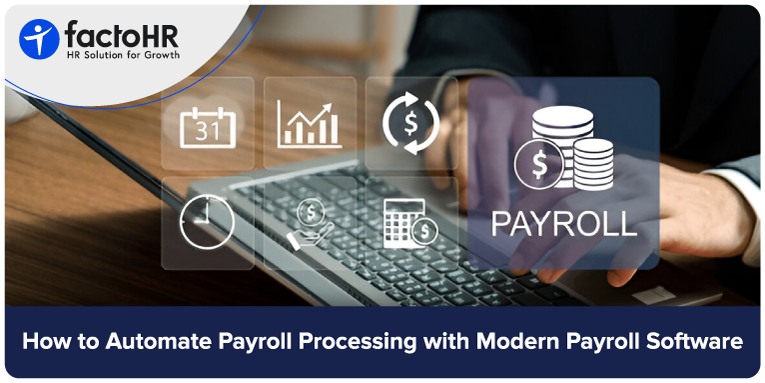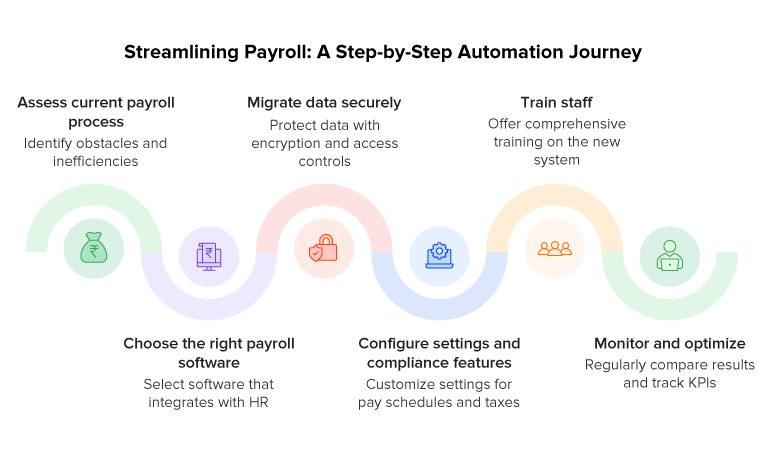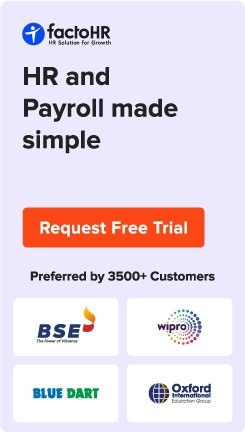How to Automate Payroll Processing with Modern Payroll Software

Table of Contents
Processing payroll manually is complex and costly for organizations in this competitive business landscape. Companies in today’s world need to be accurate, efficient, and compliant with all relevant payroll rules and regulations. This is where knowing how to automate payroll processing with modern payroll software can be helpful. It can help simplify complex calculations and payroll workflows while minimizing human errors.
Traditional payroll processes are disintegrated, with both internal and external platforms, hindering the data flow between attendance and leave management, banks, and accounting software. A payroll system that is automated is not only fast but also improves data management and security while providing various reports in real-time to help HR and managers make informed decisions. Adapting to change and embracing payroll automation is no longer a luxury but an absolute necessity for staying relevant in a highly competitive market. This blog explains how to automate payroll processing and provides a step-by-step guide to implement this change and turn it into action.

Why Automate Payroll?
Automatic payroll brings about notable changes in how an organization operates and manages payroll. Like any transformation, it is important to understand the ‘why’ behind the changes.
Below-mentioned are the main benefits of automating payroll:
- Automated payroll processes reduce manual effort, save time, and allow HR and payroll teams to focus on more strategic tasks.
- Automation of payroll improves accuracy by reducing human errors in calculations and data entry.
- Automated systems help adhere to tax laws, labor regulations, and reporting requirements by applying accurate tax rates, deductions, and withholding rules.
- Payroll automation improves cost efficiency by eliminating manual processes and reducing administrative costs.
- Efficient payroll administration has a positive impact on employee morale and reduces turnover.
What are the Steps to Automate Payroll Processing?
Changing the payroll process is a significant shift for an organization that requires careful planning and preparation. The way your organization manages the transition depends on several factors, including its size and existing payroll process.

Modernizing payroll can be a challenging task for HR and payroll teams. A common question that arises is: What should be the initial step toward automating payroll processes? Identifying the initial point is essential for a successful transition.
Here’s a detailed outline to guide you through the process.
Step 1: Assess Current Payroll Process
Reviewing your current payroll process is important when introducing automation. It helps you identify obstacles and tasks that are prone to errors. Basically, it guides you in prioritizing improvements and choosing the right tools for your organization’s requirements.
To conduct an audit of the existing payroll process, list the tasks currently handled manually, detect frequent errors or inefficiencies, and examine overlaps or data silos between systems.
Step 2: Choose the Right Payroll Software
To automate the payroll process for an organization, it’s very important to select the right payroll software that integrates with your existing HR system. There are several payroll software options, varying from simple solutions designed for small organizations to advanced, all-in-one platforms built to handle the complex requirements of large organizations.
Check out features like monitoring time and tax calculation, and make sure they integrate seamlessly with existing HR and finance systems.
Step 3: Migrate Data Securely
Before moving data from old systems to a new one, make sure it’s protected with strong encryption, keep sensitive info safe, and set up strict access controls.
Use migration tools, upload data files, or fill in data manually when needed. Ensure the data is correctly formatted for the new system.
Verify records, execute sample payrolls, and compare the imported data to the original to ensure accuracy. Develop a checklist to ensure that all data points have been accurately transferred and recorded.
Step 4: Configure Settings and Compliance Features
Following the setting of your payroll automation system. Customize the settings for pay schedules, pay types (including hourly, commissions, and salary), benefits, deductions, allowances, and regional tax regulations. Configure workflows for bonuses, deductions, and overtime.
Make sure that your payroll automation software complies with rules and regulations, as failure to do so can result in fines and penalties. Modern payroll solutions are cloud-based, so you can use them throughout your organization and access payroll information from anywhere you work.
Step 5: Train Staff
Offer comprehensive training to employees, managers, and administrators to ensure they fully understand the new system, its workflows, and how to use it efficiently.
Step 6: Monitor and Optimize
Taking preventive measures to protect payroll processes from errors, data breaches, and inefficiencies. This includes:
- Regularly comparing automated payroll results with past payroll calculations can help spot significant differences that might indicate an issue.
- Monitoring employee salaries ensures they are processed correctly and on time.
- Confirming that the system retains records for the required duration and that these records are easily accessible.
- Tracking key KPIs, like time and cost savings. If these metrics do not meet targets, explore the reasons.
- Assessing data storage and access control vulnerabilities, reviewing system access logs, and ensuring regular and secure backups of payroll data.
- Validating system integrations to make sure that data is transferred completely and accurately.

What are the Common Challenges when Automating Payroll?
Payroll automation improves efficiency and facilitates flexible payroll processes, yet it still presents significant challenges. Regardless of your role—whether you are a payroll manager, HR manager, or business owner—having a clear understanding of payroll challenges is crucial to preventing errors and enhancing operational efficiency.
Common challenges when automating payroll include:
- Integration: Integrating payroll automation with existing HR systems can be a complex process. It is very important to ensure compatibility with existing systems to prevent disruptions and facilitate smooth implementation.
- Resistance to change: Resistance to change can hinder the adoption of an automated payroll system. Proper training and change management are necessary to help HR and finance teams adapt to new technologies and workflows.
- Complex compliance across countries: Payroll compliance is very regional, which means that varying regional regulations and requirements may hinder automating certain workflows and processes or require specific workarounds.
- Investment: The high initial cost of payroll automation may obstruct its implementation. Payroll and HR teams must carefully evaluate the financial commitment and anticipated ROI(return on investment) to justify the investment and create a compelling business case for payroll transformation.
- Maintenance: Updates reflect changes in payroll laws or technological advancements. On-premises updates may incur expenses depending on the vendor contract and internal IT resources.
- Security: Automating payroll definitely boosts efficiency, but it also brings important security challenges, especially when it comes to protecting data and staying compliant with regulations. Organizations must proactively address cybersecurity risks, ensure data integrity, control access to sensitive information, and stay aligned with ever-changing compliance requirements. Cloud-based payroll providers protect your data with strong encryption, continuous monitoring, and regular updates to keep everything secure.
- Dependence: Instances of technological failure are uncommon but still possible, often beyond the control of both the software vendor and the customer.
Software updates can introduce compatibility issues with existing human resource (HR) systems. Cloud-based payroll solutions address these issues by shifting maintenance and updates to the service provider.
Organizations should implement business continuity plans that include backup processes for critical payroll operations, such as alternative methods for processing and distributing pay if primary systems are unavailable.

What are the Features to Look for in Modern Payroll Software?
Payroll involves more than just processing salaries; it requires compliance with regulations, accurate record-keeping, and the prevention of costly errors. Payroll mistakes can cause penalties, strained employee relationships, and a damaged reputation—issues that no organization can afford.
Selecting the right payroll software begins with identifying the features that align with your organization’s specific requirements. Below are the key features to consider when evaluating payroll solutions:
Automated Calculations
The payroll software ensures automated calculation of employee salaries, wages, bonuses, overtime, commissions, deductions (including taxes, benefits, and retirement contributions), and other relevant expenses.
Compliance Management
Using automated software helps organizations guarantee accurate calculations, proper tax deductions, and ongoing payroll compliance.
The software helps the payroll team stay up to date with ever-changing laws, thereby reducing the risk of non-compliance, fines, and penalties.
Integration
For payroll automation software to function effectively, seamless integration with existing systems—like accounting, attendance, and HR systems—is very important for a hassle-free and efficient workflow.
This system integration streamlines processes, reduces time, and supports better decision-making by providing a holistic view of workforce data.
Employee Self-Service
The employee self-service portal has become one of the most notable features in payroll software. With this portal, employees can access their payroll information, submit reimbursement claims, view payslips, and report issues, all from a single platform.
This autonomy reduces the workload on HR teams while improving the accuracy of employee data, creating transparency, and increasing trust by giving them control over their payroll-related queries.
Reporting and Analytics
The automated payroll system not only manages employee compensation but also generates reports on payroll data, including taxes, benefits, and total pay. These reports give insight into payroll expenses, tax liabilities, and other related information.
They are also helpful for generating audit reports. With these reports and analytics at their fingertips, managers and directors can spot trends, monitor payroll expenses, and make data-driven financial decisions.

Conclusion
The way organizations process payroll has undergone significant changes over the years. Using automated payroll platforms simplifies the process by reducing errors and streamlining the workflow. Additionally, it helps organizations remain up-to-date on tax rules and labor laws, so they can meet all their legal requirements without stress.
The benefits of automating payroll are notable, including saving time and cost, as well as improved employee satisfaction. An organization can use factoHR’s payroll software to automate its payroll process to be more efficient, ensuring compatibility with the right application and strategy.
Looking to automate your payroll process but confused about how to start? Schedule a demo today!
Grow your business with factoHR today
Focus on the significant decision-making tasks, transfer all your common repetitive HR tasks to factoHR and see the things falling into their place.

© 2026 Copyright factoHR


